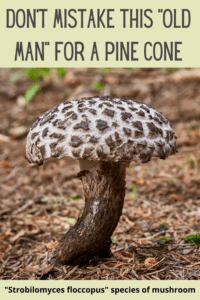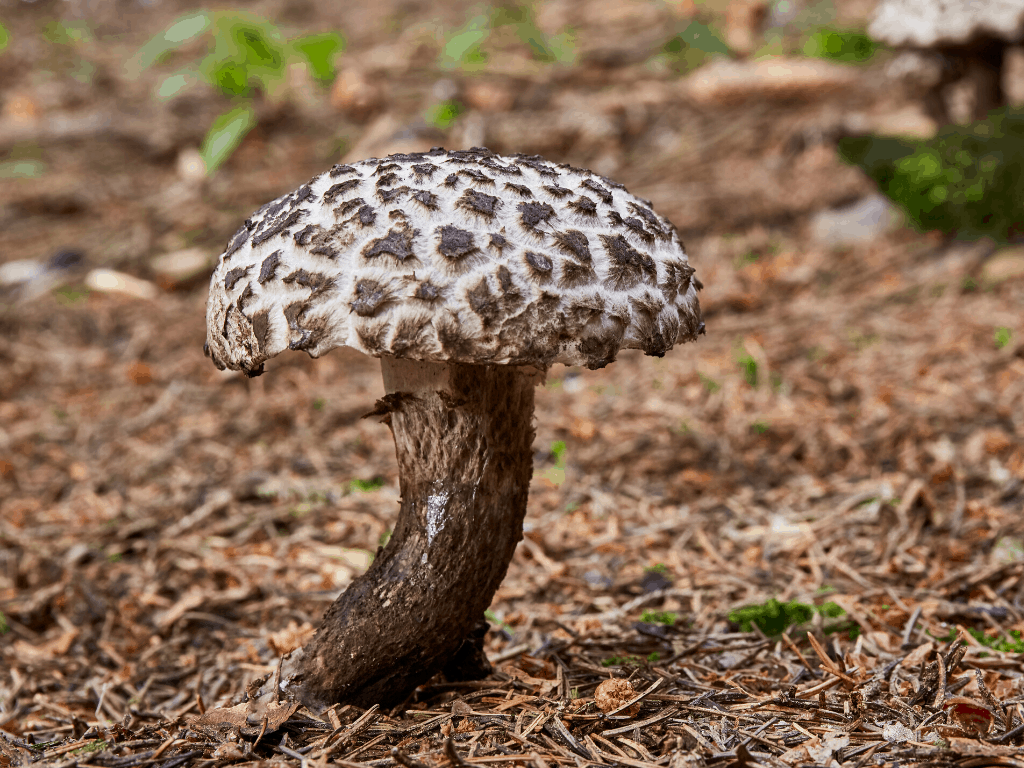If you’re out foraging for mushrooms and find one that resembles a pine cone, you may have stumbled upon an Old Man.
The Old Man of the Woods mushroom has been so named in recent decades because of its resemblance to an old man living in the woods.
But its original, scientific name, Strobilomyces floccopus, roughly translates to “woolly mushroom that looks like a pine cone.”
This should assure you that this fungus is unique in its look: its colors are black and white and gray; it looks woolly and scaly; and its overall look is shaggy. Hence it is said to look like an old man living in the woods, with a wrinkly face and gray shaggy beard.
When cut open, its flesh is white but will turn pinkish red, and then slowly blacken within about 60 minutes.
Let’s further explore this unique fungus.
Where Can You Find Them?
This mushroom fruits from July to October in North America (particularly Eastern North America) and is also common in Europe. It can be found on the ground in mixed hardwood forests and sometimes under a conifer. It especially likes oak trees. It’s most common in low mountain ranges and alpine areas and is less common in lowlands.
It often grows as a single mushroom, and blends in with dead leaves, which is why its original name refers to the fact it looks more like a rotting pine cone than a mushroom.
Strobilomyces strobilaceus and its Ecology
The scientific name for Old Man of the Woods is Strobilomyces strobilaceus, sometimes called Strobilomyces floccopus.
The ecology of this fungus is somewhat complex. Strobilomyces is actually a genus of mushrooms known as boletes, with recent evidence placing it into the larger family known as Boletaceae.
This family of mushrooms has a spongy mass of pores under their caps and the most common species is the Strobilomyces strobilaceus or Strobilomyces floccopus, which we know as “Old Man of the Woods.”
The genus Strobilomyces is broadly distributed geographically and serves an important ecological function, but it has proven difficult to identify independent species.
In one study, researchers examined the relationships between the species in an attempt to understand the diversity. They collected specimens from five continents and identified many different species, with the conclusion that there are a total of 31 distinct species of the Strobilomyces.
Description of Strobilomyces strobilaceus
The genus name of this mushroom doubles as a description of its appearance. That’s because its origin is the Ancient Greek word Strobilos, meaning “pine cone.” The ending “-myces” is a standard suffix meaning “mushroom.”
Members of this genus are distinguished by these characteristics:
- the cap is covered in soft hairy or woolly scales
- the spores of Strobilomyces are roughly spherical
- its “dry” fibrous appearance makes it more resistant to decay than others in the boletes category
How Do You Identify this Type of Mushroom?
Truly an unusual yet edible wild mushroom, the Old Man has a cap of convex shape, measuring 1 to 6 inches. It’s dry and whitish, covered with grayish-black “woolly” scales that almost look like tufts of hair.
Others have described the caps as looking cracked, like bread that has been scored and then baked. The look of the wooly scales is sometimes described as feathery. Underneath the cap are pores, not gills.
On the stem, there’s also a fine layer that looks like dark fur. When the mushroom is cut open, the flesh is initially white, but then turns pink after you cut it. Within an hour or so, the flesh will turn black after exposure to air.
The Old Man of the Woods is a mycorrhizal mushroom, which means that it has a symbiotic relationship with the plant (typically a tree) it takes on as a host. That also means both the mushrooms and the trees benefit.
This also indicates they typically don’t grow on dead material, but instead latch on close to a live plant’s root system. The mushroom and the plant both receive better access to nutrients deep within the soil.
The Old Man of the Woods is important to the forest ecosystem by covering the surface of a tree’s roots with its own netlike fibers. The surface of the tree’s roots is increased, which allows the tree to better absorb water and other nutrients. In exchange, the mushroom gains from having access to the tree’s nutrients.
Can you eat Old Man of the Woods? As with any wild mushroom, it’s best to get confirmation of its species and that it’s safe to eat before cooking with it.
How Can You Cook an Old Man of the Woods?
If you’re wondering: What can I do with Old Man of the Woods? This mushroom is best picked when young, and should be cooked before eating. If you leave the “Old Man” to get too old, it can be crusty and tasteless. It can be cooked like any other mushroom, although it doesn’t have a long history of being a popular culinary fungus.
Experiment cooking with it. Sauté it in butter and garlic, or add it to soups or gravies. How does Old Man of the Woods taste? The flavor is described as mellow and earthy, similar to other store-bought mushrooms like the button mushroom.
If you’ve found it while foraging in the wild, check whether the mushroom is rare in your area before picking it. If it is uncommon, consider leaving it to grow and propagate, rather than pick it. Since the taste is not distinctive, it might be better to leave it to reproduce and look for a more common mushroom to pick.
Is Old Man of the Woods Good For You?
There aren’t clinical studies that specifically identify Old Man of the Woods as providing specific medicinal mushroom health benefits. However, as with most mushrooms, they are healthy. Mushrooms are low in calories and sodium, high in fiber, vitamins and minerals, and free of fat and cholesterol.
Mushrooms also have antioxidant properties, and some clinical studies indicate anti-tumor properties, brain-boosting power, and other medicinal benefits in mushrooms.
So you really can’t go wrong with mushrooms, which also give a flavor and texture boost to any meal, whether cooked or raw. Is Strobilomyces poisonous? No, but Old Man of the Woods should be cooked before eating.
Recipe Using Old Man of the Woods
If you’re looking for a way to try the Old Man of the Woods, then this creamy mushroom soup recipe, adapted from Docaitta, is an option, although it can be made with any type of fresh mushroom.
Hungarian Mushroom Soup
Makes 6 servings.
Ingredients:
- 4 tablespoons unsalted butter
- 2 cups chopped onions
- 1 pound Old Man of the Woods mushrooms, sliced
- 2 teaspoons dried dill weed
- 1 tablespoon paprika
- 1 tablespoon soy sauce
- 2 cups chicken broth
- 1 cup milk
- 3 tablespoons all-purpose flour
- 1 teaspoon salt
- ground black pepper to taste
- 2 teaspoons lemon juice
- 1/4 cup chopped fresh parsley
- 1/2 cup sour cream
Directions:
- Melt the butter in a large pot over medium heat. Sauté the onions in the butter for 5 minutes. Add the mushrooms and sauté for 5 more minutes. Stir in the dill, paprika, soy sauce and broth. Reduce heat to low, cover, and simmer for 15 minutes.
- In a separate small bowl, whisk the milk and flour together. Pour this into the soup and stir well to blend. Cover and simmer for 15 more minutes, stirring occasionally.
- Finally, stir in the salt, ground black pepper, lemon juice, parsley and sour cream. Mix together and allow to heat through over low heat, about 3 to 5 minutes. Do not boil. Serve immediately.
Final Thoughts
Foraging for mushrooms in the wild allows you to combine fresh air and exercise with being in the wilderness, and of course the excitement of finding food for supper.
The Old Man of the Woods mushroom is a lesser-known fungus that’s worth keeping an eye for while you’re out in the woods.
Like This Article? Pin it on Pinterest

Sources:
https://www.mushroomexpert.com/strobilomyces_floccopus.html
https://www.ediblewildfood.com/old-man-of-the-woods.aspx
https://www.first-nature.com/fungi/strobilomyces-strobilaceus.php






